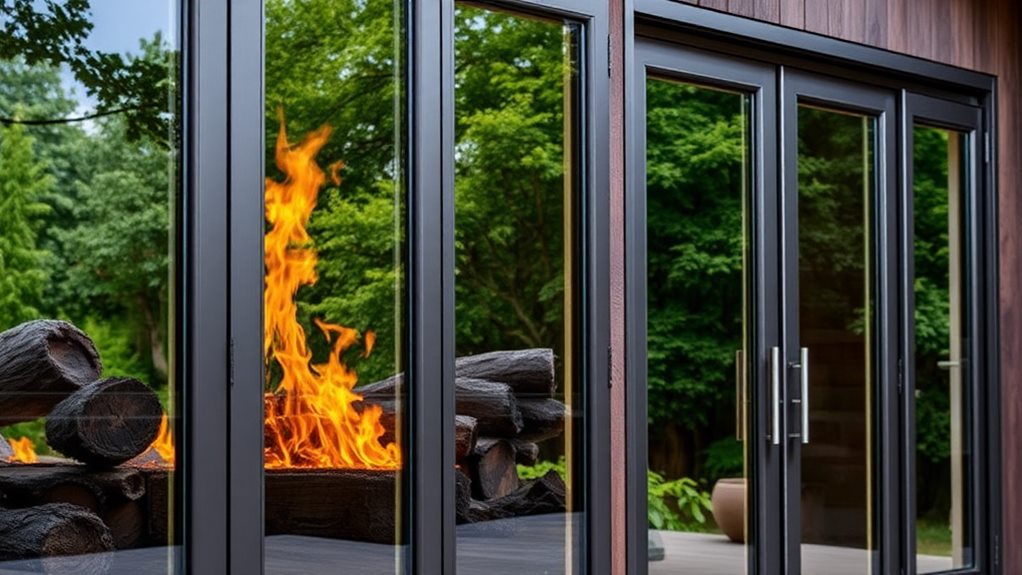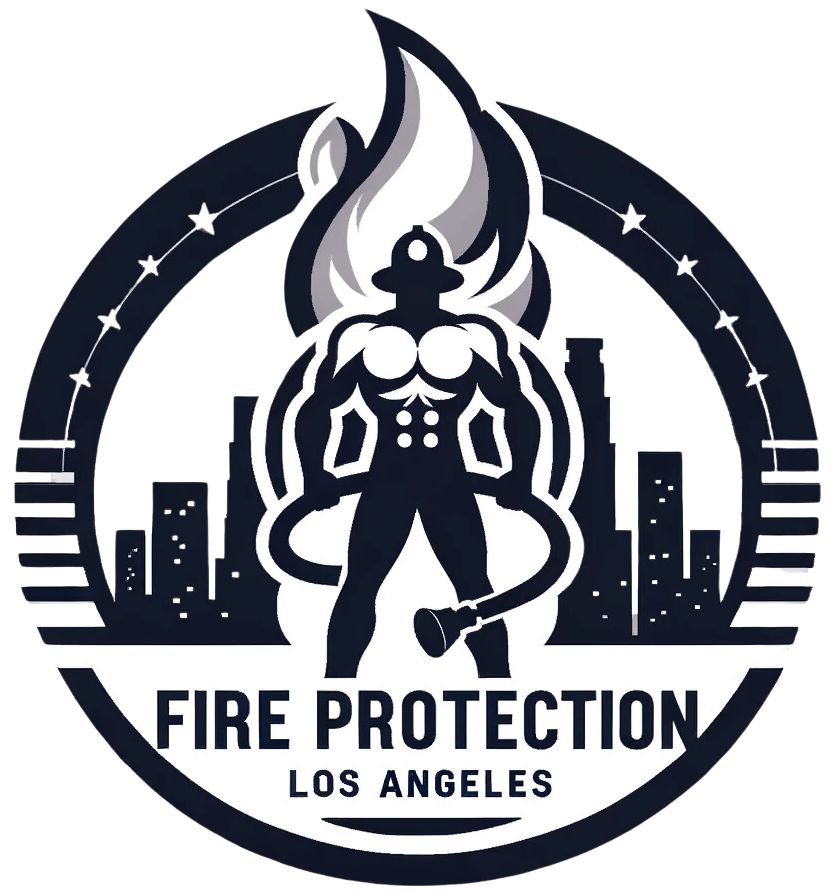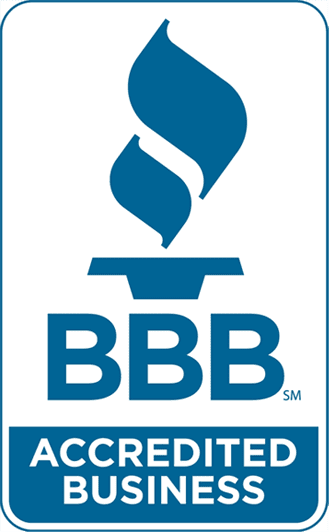When we choose the best materials for home fireproofing, we focus on fire-resistant options like concrete, steel, gypsum board, and brick. These materials slow the spread of fire, providing essential safety. We'll want to take into account fire ratings, which indicate how long a material can withstand fire before failing. Additionally, incorporating fire-resistant insulation, windows, and doors can further enhance fire safety. Following local building codes guarantees compliance and can lower insurance costs. By using a combination of these materials, we create a safer home environment. Keep exploring to discover more effective strategies for fire protection.
Fire-Resistant Material Overview

When we think about fire safety in our homes, choosing fire-resistant materials is essential. These materials play an important role in enhancing building safety by slowing the spread of fire and giving us extra time to evacuate during emergencies.
The use of fire-resistant materials and insulation is an important aspect of effective fireproofing. Common fire-resistant materials include concrete, steel, gypsum board, and various insulation options. Each of these has unique temperature tolerance levels that help determine their effectiveness in a fire.
For instance, concrete can withstand temperatures up to 1000°C for about 60 minutes, making it an excellent choice for structural components. Steel, however, begins to weaken above 600°C, so it often needs protective measures to maintain its structural integrity.
Gypsum board is particularly popular due to its noncombustible core, which helps slow heat transfer and can provide up to a one-hour fire resistance rating.
Additionally, fire-resistant insulation options like fiberglass and mineral wool are valuable for improving overall fire resistance. Understanding how these materials handle fire exposure is important for making informed decisions about our home's construction.
Key Fire Resistance Ratings
Selecting fire-resistant materials is just the beginning of ensuring our homes are safe from fire hazards. Understanding fire resistance ratings is vital for effective fire protection. These ratings indicate how long a material can withstand fire exposure before its structural integrity is compromised, typically classified into one-hour and two-hour ratings.
Additionally, the application of specialized coatings and materials can enhance the overall fire resistance of residential structures, providing essential time for evacuation and firefighting efforts during emergencies innovative fireproofing solutions. The flame spread index also plays a significant role in fire safety. It classifies materials based on their ability to propagate flames. Class A materials, like bricks and rock wool, have a flame spread rating of 0-25, while Class C materials, including faster-burning woods, range from 76-200.
Building codes often mandate specific fire resistance ratings for various materials, ensuring compliance with safety standards and minimizing fire spread in our homes.
To determine the fire performance of materials, we rely on fire resistance testing standards like ASTM E119 and UL 263. By familiarizing ourselves with these ratings, we can make informed choices about fire-resistant roofing and other essential materials.
This knowledge empowers us to enhance our homes' fire safety and protect our loved ones from potential hazards. Let's prioritize these ratings in our building designs for a safer living environment.
Essential Fire-Resistant Materials

In our quest for a fire-safe home, understanding essential fire-resistant materials is crucial to safeguarding our living spaces. Fire protection experts emphasize the importance of using materials that enhance fire resistance and structural integrity.
For instance, concrete can withstand temperatures up to 1000°C for about 60 minutes, making it an excellent choice for building foundations and walls. Fire-resistant materials are increasingly adopted for their ability to withstand intense heat and contribute to overall home safety.
Gypsum board, often found in walls and ceilings, offers inherent fire resistance with a rating of up to one hour due to its noncombustible core, which slows heat transfer.
Brick is another highly fire-resistant material that can endure temperatures up to 1200°C, providing durability and thermal mass properties, especially in external walls.
While steel structures are common, they require fire protection measures, as steel weakens at temperatures above 600°C. To enhance safety, we can apply intumescent paint to steel components.
Additionally, fire-resistant insulation materials, like fiberglass and mineral wool, can tolerate temperatures up to 1220°C, greatly improving overall building safety and energy efficiency.
Building Codes and Compliance
While understanding fire-resistant materials is essential, we must also pay close attention to building codes and compliance standards. Local building codes often dictate the minimum fire-resistance ratings for materials used in construction, ensuring we meet necessary safety standards.
The importance of fire safety knowledge and action is vital in this context, as it helps homeowners make informed decisions about their fireproofing efforts. The International Building Code (IBC) provides detailed guidelines on fire safety measures, specifying the required fire-resistance ratings based on the type of occupancy and building height.
Fire-resistance ratings are measured in hours, showing how long materials can withstand fire exposure without compromising structural integrity. Common ratings include 1-hour and 2-hour classifications.
Regular inspections and adherence to local building codes are vital for maintaining compliance. Following these regulations can even lead to reduced insurance premiums for property owners.
Innovations in Fire Safety

As we prioritize compliance with building codes and fire safety standards, it's exciting to explore the latest innovations in fire safety that enhance our protective measures. One noteworthy advancement is the use of intumescent coatings for steel. These coatings expand when exposed to heat, creating an insulating barrier that protects the underlying material from high temperatures.
Additionally, advanced composites with fire-resistant properties are being developed, which help maintain structural integrity while reducing weight, making them ideal for modern construction.
We also see the integration of smart technologies, such as fire detection systems that automatically activate sprinklers, improving early warning capabilities and response times during fire incidents. Research into bio-based materials, which possess inherent fire retardant capabilities, aligns with sustainability efforts in building design, promoting both safety and environmental responsibility.
Moreover, innovative fire-resistant glass technologies, like dual-paned tempered glass, provide increased strength and protection against heat. This considerably delays breakage and prevents fire from entering buildings.
Evaluating Insulation Options
Choosing the right insulation is essential for fire safety and energy efficiency in our homes. When we evaluate insulation options, we must consider fire resistance and thermal performance.
Fiberglass insulation is a popular choice, capable of withstanding temperatures up to 104°C, with R-values ranging from R-2.9 to R-3.8. However, mineral wool insulation stands out for its superior fire-resistive qualities, enduring temperatures up to 1,220°C and offering R-values between R-2.8 and R-3.5.
While foam insulation provides good thermal efficiency, it's crucial to recognize that it remains combustible at higher temperatures, making it less ideal for fireproofing. In contrast, treated cellulose insulation creates a fire-resistant barrier that slows flame spread, making it a safer alternative to standard insulation materials.
Ultimately, when choosing insulation, we want to blend fire-resistant materials with excellent thermal efficiency. The right insulation not only enhances our homes' safety against fire but also improves overall energy performance.
Fire-Resistant Windows and Doors

When it comes to fire safety, selecting fire-resistant windows and doors is essential for protecting our homes.
Choosing fire-resistant windows, like insulated double-glazed options with tempered glass, can greatly enhance our safety. These windows endure heat better than single-pane varieties, delaying breakage and reducing the risk of flames entering our homes.
Steel entry doors are another vital component of fire protection. They can provide up to 90 minutes of fire resistance, giving us valuable time to escape in case of an emergency.
For those who want a blend of style and safety, fire-rated wood doors are available, offering aesthetic appeal without compromising on fire resistance.
Additionally, we should consider steel framing for our windows. This material offers superior fire resistance compared to wood or vinyl, making it ideal for fire-prone areas.
Final Thoughts
In summary, choosing the right materials for fireproofing our homes is essential for safety and peace of mind. By understanding fire-resistant materials, codes, and innovations, we can make informed decisions that protect our families and properties. Remember, when it comes to fire safety, an ounce of prevention is worth a pound of cure. Let's commit to using the best materials available, ensuring our homes are not only beautiful but also prepared for whatever comes our way.








